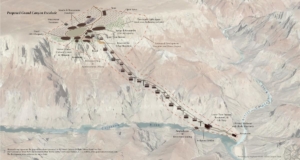The Confluence of Two Worlds
 The Confluence by Ted Grussing
The Confluence by Ted Grussing
There are places which are meant to be hard to reach, difficult to climb, even life-threatening to attain. Those places remind us, both those who reach them and those who refrain, what it means to be challenged, to have succeeded and to have failed.
In a century in which we have gained the ability to build a road, bridge, or transport to just about any place on Earth, this does not mean that we should. We must maintain the hard-to-reach places as hard to reach, for when our body carries us to the peak of a mountain, to the far reaches of a river, we are reminded what it means to be the human animal. We are far more than the hi-tech shoes, quick dry pants, and micro-fiber tops that we wear. The skin made raw, the loss of breath, the pain in our side, that is what makes those hard-to-reach places come alive.
 Right now, there is a proposal to deliver to the bottom of the Grand Canyon as many as 10,000 people per day by way of a tram. This serves no purpose other than to make money for those who have invested, at the expense of the very people who are native to this land.
Right now, there is a proposal to deliver to the bottom of the Grand Canyon as many as 10,000 people per day by way of a tram. This serves no purpose other than to make money for those who have invested, at the expense of the very people who are native to this land.
The pending change to the ecology of the confluence of those two rivers will be yet another story told in hindsight, heads shaking as we realize what we have done in the name of tourism and making money. But the untold story, the one that has no data to support the claim, is that every time we convert a journey into a ride, we take from our children’s imagination, another source of inspiration stolen from our collective memory. What will we aspire to if all challenges are removed, if those few remaining, isolated places are instead the site of a restaurant?
If Grand Canyon Escalade resort is ratified by the Navajo Nation, it will radically alter the very way in which we view and enter one of this planet’s greatest natural treasures, a sacred place for us all.
To learn more, visit the Grand Canyon Trust and Save the Confluence. Then get involved. Let the National Park Service and Navajo Nation know this is unacceptable, that the Grand Canyon should be preserved.






